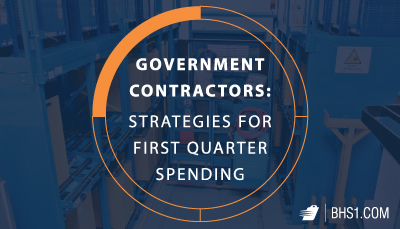We use cookies to make your experience better. To comply with the new e-Privacy directive, we need to ask for your consent to set the cookies. Learn more.
Government Contractors: Strategies for First Quarter Spending
The Fiscal Year 2018 ended on September 30. The traditional wisdom in the industry holds that the fourth quarter is by far the busiest for government contractors, and for the most part, that's true.
However, according to GSA Schedule sales figures, Q1 is nearly as active as Q4. In fact, the first quarter is a remarkable time to go for contracts. Between 2006 and 2015, GSA sales trends peaked in Q4, with about $9.5 billion in spending. The first quarter, meanwhile, was the second most active, with an average of $9.2 billion in sales through the GSA.

Given that quarter four traditionally sees the highest government spending in the fiscal year, it's the ideal time to make a marketing push to capture as much of the business as you can before it's too late. By the same logic, Q1 should remain one of the busiest parts of the year.
With that in mind, here are a few things that every government contractor should know as we transition from the rush of Q4 into the rich opportunities of Q1:
-
Make sure you're up-to-date on GSA Advantage!, SAM, and FBO.
While this may sound obvious, you can't sell a product or service if you forget to add it to your catalog. GSA deals move through a variety of platforms, including the ecommerce vehicle GSA Advantage!, the free-to-use System for Award Management (SAM), and the contract-search site Federal Business Opportunities, or FedBizOpps.gov. With these systems in place, staying up to date is a bit more complex than simply adding new products to your own website.
-
Invest in equipment upgrades during the first quarter, while you still have Q4 liquidity.
The first quarter is an ideal time to make capital investments. Improve efficiency and work processes well in advance of the Q4 rush, so you'll have your new systems fully online when the real busy season begins. For instance, Q1 is a great time to replace important facility infrastructure, including Forklift Battery Rooms and material handling equipment.
-
Tweak your RFP strategies with efficiency in mind.
The quicker you can turn around high-quality responses to a GSA Request for Proposal or Request, the more competitive you'll be. The start of the fiscal year is an ideal time to make minor changes that can improve RFP response time significantly, such as outsourcing the final proofing of all documents. Often, professional copy editors can spot errors that escape proposal writers, who are very close to the content.
These tips apply to all U.S. government contractors, but construction firms may find them particularly significant. For construction companies that work with the GSA, it pays to prepare for what's coming down the pipe for fiscal year 2019. At the time of this writing, federal construction accounts were already worth nearly $1.65 billion, according to the Associated General Contractors of America (AGC), so FY2019 will be great for service providers who win the contracts.
The time for government contractors—especially those in the construction field—to take advantage of these opportunities is not limited to Q4. The truth is, for government contractors, the RFP cycle goes all year round.
References:
"AGC Summary of Federal Construction Accounts FY 2019 Budget Request." AGC. Associated General Contractors of America, 2018. PDF. 23 Aug. 2018.
"GSA Schedule Fiscal Year End Sales." FEDSched. Federal Schedules, Inc., Sept. 30, 2016. Web. 24 Aug. 2018.
"How to Prepare Government Contract Proposals." SBA. U.S. Small Business Administration, Feb. 2014. PDF. 24 Aug. 2018.
Lancaster, Kevin. "5 Tips to Leverage the Q4 Spending Spree." Winvale. Winvale, 30 June 2016. Web. 23 Aug. 2018.
